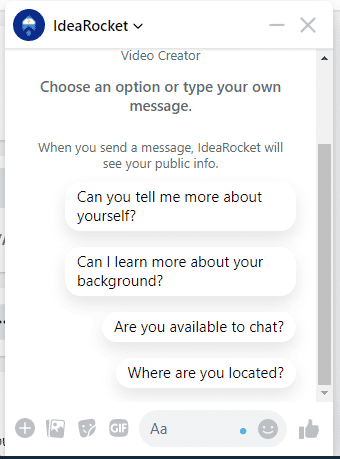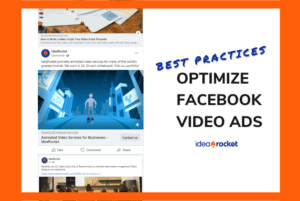If you’ve gone to a website seeking customer service lately, you may have noticed something new. More businesses are adding chatbots to their websites, and a few have even added video chatbots. Now you might be wondering if your own business website could benefit from this technology. Is it the next evolution of customer service, or just a passing fad?
We’ll try to answer those questions. But before we jump in, let’s talk about what a chatbot is and why video chatbots are suddenly appearing on websites.
What is a video chatbot?
A chatbot is an artificial intelligence that can respond to users in ways that mimic real conversation. Text chatbots are common features on many customer-facing websites. If you have a business Facebook page, you might already have the built-in chatbot enabled there.

At their simplest, chatbots work as an interactive FAQ page to serve up articles that answer common questions from users. More complex chatbots learn as they converse and are able to deliver more customized information. These more sophisticated chatbots become increasingly skilled with each interaction.
A video chatbot is a bot that uses video to interact with users. This may mean that it serves up videos from the site to answer common questions. More sophisticated versions might include an animated character who seems to interact with the user.
Are video chatbots new?
Video chatbots aren’t as new as you might think. The first chatbot was created in 1966, almost a decade before the first personal computer hit the shelves. If you were around in the mid-90s you might remember Clippy, the interactive “assistant” that first appeared with Office 97. These early chatbots set the stage, but they weren’t exactly a worldwide sensation.
So what happened?
Chatbots are seeing a resurgence now because AI technology is finally starting to catch up to the vision of what chatbots could be. As technology evolves, AI is becoming more adept at understanding the way we write and speak.
Customer expectations are also changing. Visitors to your website now expect 24-hour service. Paying customer service people to take calls at 3 a.m. might be cost prohibitive, but a chatbot is always available. Besides, many customers prefer chat to phone calls. So a bot that can quickly answer their questions without a phone call seems like a winning strategy.
Adding video to your chatbot gives it a personality, which can improve the customer experience if it’s done well. Unfortunately, getting this right can be difficult. Without appropriate parameters, bots can sometimes make logical keeps that don’t help the customer. Overly intrusive bots can be annoying, and the customer should always have a way to reach a real person, even if that’s by a slower form of communication like email.
Despite the challenges, many businesses see value in video chatbots. They’re more immersive than text bots, can provide step-by-step walkthroughs that might be tiresome in text, and portray a cutting-edge image.
Types of video chatbots
Without getting into the technical specifications, there are three general types of video chatbots you could choose from. Each of these serves a unique purpose and portrays a certain image. The right one for your business is the one that aligns with your business goals and brand image.
1. Video serving chatbot – The simplest form of chatbot, these serve up video clips in response to user questions. They’re the least expensive since they require no special animations or graphics. You can even reuse clips from videos you already have, or make new shorts to answer specific user questions.
Here’s an innovative example from Stanley Tate. Tate Law specializes in Student Loan Law. His chatbot plays a short video, then invites interaction from the user to decide which video to play next.

2. Animated avatar chatbot – Like Microsoft’s Clippy, animated character chatbots use an animated figure to add personality to the interaction. You can use an existing brand mascot or create one specifically for this purpose. Character design and animation make these chatbots more expensive than the video serving type, but it can be worth the investment if it makes sense with your brand strategy.
3. Anthropomorphic (trapped in the Uncanny Valley) – These chatbots try to look human, with mixed results. Expensive and difficult to get right, these chatbots probably aren’t the right fit for most businesses just yet.
In the example below, the combination of creepy hyperrealistic characters and odd conversational leaps can either amuse or horrify viewers.
(disclaimer: this video shows two bots in a conversation with each other. No human or business takes responsibility for what they say.)
Does your business need a video chatbot?
Keep in mind, that an effective chatbot uses a lot of technology behind the scenes. You need either the technical expertise or the budget to hire an expert to create one that improves the user experience. Yet simple video serving bots are becoming more and more accessible. You can expect to see them popping up on all kinds of websites in the next few years.
Whether a chatbot is right for your website depends on a few factors. If your users prefer to watch videos instead of reading articles, a chatbot might better meet their needs. If showing users how to do something makes more sense than telling them, a chatbot can help. For brands that want to portray a warm, approachable, playful, or friendly brand persona, animated avatar chatbots might be worth the investment.
A simple video-serving chatbot is probably the best place for most brands to start. Of course, you need videos for your chatbot to serve, and that’s where IdeaRocket comes in. We can help you make high-quality videos that exemplify your brand. Contact us today to get started.



